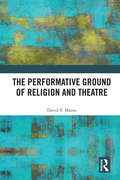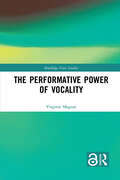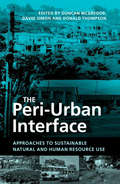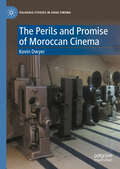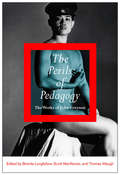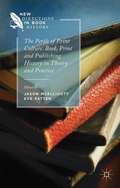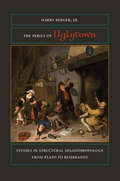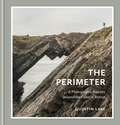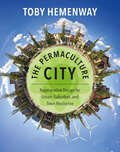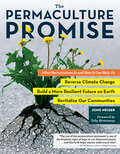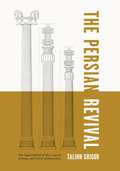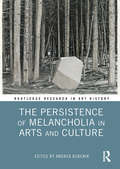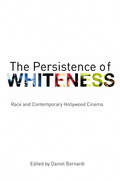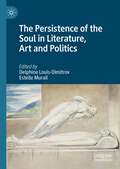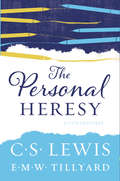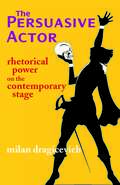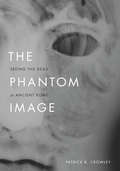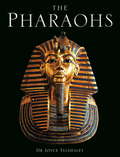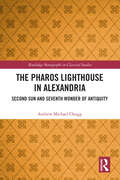- Table View
- List View
The Performative Ground of Religion and Theatre
by David V. MasonReligious practitioners and theatregoers have much in common. So much, in fact, that we can say that religion is often a theatrical phenomenon, and that theatre can be a religious experience. By examining the phenomenology of religion, we can in turn develop a better understanding of the phenomenology of theatre. That is to say, religion can show us the ways in which theatre is not fake. This study explores the overlap of religion and theatre, especially in the crucial area of experience and personal identity. Reconsidering ideas from ancient Greece, premodern India, modern Europe, and the recent century, it argues that religious adherents and theatre audiences are largely, themselves, the mechanisms of their experiences. By examining the development of the philosophy of theatre alongside theories of religious action, this book shows how we need to adjust our views of both. Featuring attention to influential notions from Plato and Aristotle, from the Natyashastra, from Schleiermacher to Sartre, Bourdieu, and Butler, and considering contemporary theories of performance and ritual, this is vital reading for any scholar in religious studies, theatre and performance studies, theology, or philosophy.
The Performative Power of Vocality (Routledge Voice Studies)
by Virginie MagnatThe Performative Power of Vocality offers a fresh perspective on voice as a subject of critical inquiry by employing an interdisciplinary and cross-cultural approach. Conventional treatment of voice in theatre and performance studies too often regards it as a subcategory of actor training, associated with the established methods that have shaped voice pedagogy within Western theatre schools, conservatories, and universities. This monograph significantly deviates from these dominant models through its investigation of the non-discursive, material, and affective efficacy of vocality, with a focus on orally transmitted vocal traditions. Drawing from her performance training, research collaborations, and commitment to cultural diversity, Magnat proposes a dialogical approach to vocality. Inclusive of established, current, and emerging research perspectives, this approach sheds light on the role of vocality as a vital source of embodied knowledge, creativity, and well-being grounded in process, practice, and place, as well as a form of social and political agency. An excellent resource for qualitative researchers, artist-scholars, and activists committed to decolonization, cultural revitalization, and social justice, this book opens up new avenues of understanding across Indigenous and Western philosophy, performance studies, musicology, ethnomusicology, sound and voice studies, anthropology, sociology, phenomenology, cognitive science, physics, ecology, and biomedicine.
The Performer: Art, Life, Politics
by Richard SennettAn acclaimed sociologist&’s exploration of the connections among performances in life, art, and politics In The Performer, Richard Sennett explores the relations between performing in art (particularly music), politics, and everyday experience. It focuses on the bodily and physical dimensions of performing, rather than on words. Sennett is particularly attuned to the ways in which the rituals of ordinary life are performances. The book draws on history and sociology, and more personally on the author&’s early career as a professional cellist, as well as on his later work as a city planner and social thinker. It traces the evolution of performing spaces in the city; the emergence of actors, musicians, and dancers as independent artists; the inequality between performer and spectator; the uneasy relations between artistic creation and social and religious ritual; the uses and abuses of acting by politicians. The Janus-faced art of performing is both destructive and civilizing.
The Performing Artist's Handbook
by Janice PapolosThe right ways to handle all of the nonmusical essentials of your career, the practical know-how you need to progress in your professional music career.
The Performing Subject in the Space of Technology
by Matthew CauseyNow that the shock of the virtual has subsided toward a 'new-normal' of computational interference in all areas of life, it is an advantageous moment to reflect on the passage through the virtual and back to the real. Digital culture has developed into a bio-virtual environment in which the categories of the biological and the virtual no longer stand as separate. The contributors to this volume respond to the questions raised by the 'after-event' of the digital through practice-led researchanalyses of performance processes, philosophical readings of the work of art and technology, and performance studies investigations of the subject in the spaces of technology. The volume examines a wide range of activities, from bio-art to internet child pornography, gaming and social networking technologies to the use of motion-tracking in developing choreography and documentation. The authors draw from diverse perspectives in dance, theatre, performance, film and music studies, digital arts and culture.
The Peri-Urban Interface: Approaches to Sustainable Natural and Human Resource Use
by David Simon Duncan McGregorPeri-urban interfaces - the zones where urban and rural areas meet - suffer from the greatest problems to humans caused by rapid urbanization, including intense pressures on resources, slum formation, lack of adequate services such as water and sanitation, poor planning and degradation of farmland. These areas, home to hundreds of millions of people, face unique problems and need distinctive and innovative approaches and solutions. This book, authored by top researchers and practitioners, covers the full breadth and depth of the impacts of rapid urbanization on livelihoods, poverty and resources in the peri-urban zones in diverse African, Asian, Latin American and Caribbean contexts. Topics include peri-urban resource sustainability, ecosystems and societies and environmental changes in peri-urban zones. Rich case studies cover production systems and livelihoods including the impacts of irrigated vegetable production, horticulture, dairy enterprises, waste-fed fisheries and pastoral livelihoods. Also addressed are planning and development issues in the peri-urban interface including the difficulty in achieving sustainability, conflict and cooperation over resources, and a fresh look at the relationship between people and their environment. The final part of the book presents policies and strategies for promoting and measuring sustainability in peri-urban zones including community-based waste management, the co-management of watersheds and empowerment of the poor. This book is the most comprehensive examination of the challenges and solutions facing the people and environments of peri-urban zones and is essential reading for all practitioners, students and academics in geography and development.
The Perils and Promise of Moroccan Cinema (Palgrave Studies in Arab Cinema)
by Kevin DwyerBased on extended field research and meetings with members of Morocco’s film world, this book traces the development of Moroccan cinema over the past three decades. Drawing from his extensive work on Moroccan cinema, Kevin Dwyer discusses important aspects of Moroccan film culture such as freedom of expression, the role of women, cultural diversity, the promotion of culture, the role of humor, the shifting emphasis on the urban, autobiographical aspects of films, and the development of documentary films. Dwyer closely analyzes a significant number of Moroccan films, providing crucial details about filmmakers; historical context; and comparisons with the cinemas of Tunisia, Algeria, and Egypt.
The Perils of Pedagogy
by Scott Mackenzie Thomas Waugh Brenda LongfellowWhether addressing HIV/AIDS, the policing of bathroom sex, censorship, or anti-globalization movements, John Greyson has imbued his work with cutting humour, eroticism, and postmodern aesthetics. Mashing up high art, opera, community activism, and pop culture, Greyson challenges his audience to consider new ways that images can intervene in both political and public spheres. Emerging on the Toronto scene in the late 1970s, Greyson has produced an eclectic, provocative, and award-winning body of work in film and video. The essays in The Perils of Pedagogy range from personal meditations to provocative textual readings to studies of the historical contexts in which the artist's works intervened politically as well as artistically. Notable writers from a range of disciplines as well as prominent experimental and activist filmmakers tackle questions of documentary ethics, moving image activism, and queer coalitional politics raised by Greyson's work. Close to one hundred frame captures and stills from almost sixty works, along with articles, speeches, and short scripts by Greyson - several never before published - supplement the collection. Celebrating thirty years of passionate, brilliant, and affecting moviemaking, The Perils of Pedagogy will fascinate both specialists and general readers interested in media activism and advocacy, censorship, and freedom of expression.
The Perils of Pedagogy: The Works of John Greyson
by Thomas Waugh Brenda Longfellow Scott MacKenzieWhether addressing HIV/AIDS, the policing of bathroom sex, censorship, or anti-globalization movements, John Greyson has imbued his work with cutting humour, eroticism, and postmodern aesthetics. Mashing up high art, opera, community activism, and pop culture, Greyson challenges his audience to consider new ways that images can intervene in both political and public spheres. Emerging on the Toronto scene in the late 1970s, Greyson has produced an eclectic, provocative, and award-winning body of work in film and video. The essays in The Perils of Pedagogy range from personal meditations to provocative textual readings to studies of the historical contexts in which the artist's works intervened politically as well as artistically. Notable writers from a range of disciplines as well as prominent experimental and activist filmmakers tackle questions of documentary ethics, moving image activism, and queer coalitional politics raised by Greyson's work. Close to one hundred frame captures and stills from almost sixty works, along with articles, speeches, and short scripts by Greyson - several never before published - supplement the collection. Celebrating thirty years of passionate, brilliant, and affecting moviemaking, The Perils of Pedagogy will fascinate both specialists and general readers interested in media activism and advocacy, censorship, and freedom of expression.
The Perils of Print Culture
by Jason Mcelligott Eve PattenThis collection of essays illustrates various pressures and concerns--both practical and theoretical--related to the study of print culture. Procedural difficulties range from doubts about the reliability of digitized resources to concerns with the limiting parameters of 'national' book history.
The Perils of Uglytown: Studies in Structural Misanthropology from Plato to Rembrandt
by Harry BergerWith characteristic wit, Harry Berger, Jr., brings his flair for close reading to texts and images across two millennia that illustrate what he calls “structural misanthropology.” Beginning with a novel reading of Plato, Berger emphasizes Socrates’s self-acknowledged failures. The dialogues, he shows, offer up, only to dispute, a misanthropic polis. The Athenian city-state, they worry, is founded on a social order motivated by apprehension—both the desire to take and the fear of being taken. In addition to suggesting new politicaland philosophical dimensions to Platonic thought, Berger’s attention to rhetorical practice offers novel ways of parsing the dialogic method itself. In the book’s second half, Berger revisits and revises his earlier accounts of Italian humanism, Elizabethan drama, and Dutch painting. Berger shows how structural misanthropology helps us to read the competitive practices that characterize Renaissance writing and art, whether in Machiavelli’s constitutional prostheses, Shakespeare’s pageants of humiliation, or the elbow jabs of Dutch portraiture.
The Perimeter: A Photographic Journey around the Coast of Britain
by Quintin LakeLONGLISTED FOR THE 2025 WAINWRIGHT PRIZE FOR ILLUSTRATED BOOKS'Every page twinkles with gems. . . Storytelling at human scale is slippery and elusive but The Perimeter is packed with geographical tales. It’s an exquisite record of a monumental endeavour and an intimate portrait of an extraordinary coast' Nicholas Crane'Astonishing . . . A fascinating, contemporary portrait of the coastline that defines us' Robert Penn'What an incredibly beautiful book, it captured my heart and took me to places I know well, reacquainted me with those I haven't visited for a while and fired my determination to visit many others. Armchair travel at its very best' Lara MaiklemA feast for the eyes and imagination. . . Quintin Lake has an unerring eye for the interesting, the witty and the beautiful. A book of stunning artistry, a remarkable adventuring achievement, and, in many ways, an invitation: to explore more, to understand more, to care more' Mary-Ann Ochota, President @CPRE the Countryside CharityRediscover Britain in this vivid and intimate full-colour account of one man’s pilgrimage along its rugged shoresOn Friday 17 April 2015, photographer Quintin Lake set off from the steps of St Paul’s Cathedral on a five-year journey that would take him around the entire coastline of mainland Britain. Armed with twenty kilos of hiking and photography gear, he walked 11,000 kilometres in 454 days with one goal in mind: to produce a body of photographic work that gets under the surface of the island nation that we call home.Carefully curated with over 1,300 photos and interspersed with stories of Quintin’s adventures, this book is an immersive visual experience that showcases Britain as you’ve never seen it before. Discover charming seaside towns such as Staithes in Yorkshire, venture to the desert landscape of Dungeness in Kent and marvel at the beautiful desolation of Scotland’s Knoydart Peninsula. Explore the contrast between industry and nature along the Welsh coast path, where plumes of steam rising from the Port Talbot steelworks are as jaw-dropping as the stunning Worm’s Head on the Gower Peninsula. And follow Quintin as he narrates the monumental challenges of wild camping – from battling with midges and stress fractures, to clambering up cliffs to escape a rising tide. Filled with striking photos that capture the glorious and often surprising world between land and sea, The Perimeter is a celebration of Britain – a small island with a vast coastline
The Permaculture City: Regenerative Design for Urban, Suburban, and Town Resilience
by Toby HemenwayPermaculture is more than just the latest buzzword; it offers positive solutions for many of the environmental and social challenges confronting us. And nowhere are those remedies more needed and desired than in our cities.The Permaculture City provides a new way of thinking about urban living, with practical examples for creating abundant food, energy security, close-knit communities, local and meaningful livelihoods, and sustainable policies in our cities and towns. The same nature-based approach that works so beautifully for growing food—connecting the pieces of the landscape together in harmonious ways—applies perfectly to many of our other needs. Toby Hemenway, one of the leading practitioners and teachers of permaculture design, illuminates a new way forward through examples of edge-pushing innovations, along with a deeply holistic conceptual framework for our cities, towns, and suburbs.The Permaculture City begins in the garden but takes what we have learned there and applies it to a much broader range of human experience; we&’re not just gardening plants but people, neighborhoods, and even cultures. Hemenway lays out how permaculture design can help towndwellers solve the challenges of meeting our needs for food, water, shelter, energy, community, and livelihood in sustainable, resilient ways. Readers will find new information on designing the urban home garden and strategies for gardening in community, rethinking our water and energy systems, learning the difference between a &“job&” and a &“livelihood,&” and the importance of placemaking and an empowered community.This important book documents the rise of a new sophistication, depth, and diversity in the approaches and thinking of permaculture designers and practitioners. Understanding nature can do more than improve how we grow, make, or consume things; it can also teach us how to cooperate, make decisions, and arrive at good solutions.
The Permaculture Promise: What Permaculture Is and How It Can Help Us Reverse Climate Change, Build a More Resilient Future on Earth, and Revitalize Our Communities
by Toby Hemenway Jono NeigerPermaculture is a sustainability buzzword, but many people wonder what it actually means and why it is relevant. Originally coined by combining the words permanent and agriculture, permaculture has evolved into an optimistic approach connecting all the systems of human life: gardening, housing, transportation, energy, and how we structure our communities. The Permaculture Promise explains in simple terms why permaculture may be the key to unlocking a livable future on our planet. Author Jono Neiger asserts that humans can thrive while simultaneously making Earth healthier and not destroying it. The book shows 22 ways that permaculture can create a better future for all living things. Profiles of people and communities — including an urban dweller who tore up her driveway to create a vegetable garden and a California housing development that dedicates a third of its land to parks, orchards, and gardens — will inspire you to incorporate permaculture principles into your life today.
The Persian Revival: The Imperialism of the Copy in Iranian and Parsi Architecture
by Talinn GrigorOne of the most heated scholarly controversies of the early twentieth century, the Orient-or-Rome debate turned on whether art historians should trace the origin of all Western—and especially Gothic—architecture to Roman ingenuity or to the Indo-Germanic Geist. Focusing on the discourses around this debate, Talinn Grigor considers the Persian Revival movement in light of imperial strategies of power and identity in British India and in Qajar-Pahlavi Iran.The Persian Revival examines Europe’s discovery of ancient Iran, first in literature and then in art history. Tracing Western visual discourse about ancient Iran from 1699 on, Grigor parses the invention and use of a revivalist architectural style from the Afsharid and Zand successors to the Safavid throne and the rise of the Parsi industrialists as cosmopolitan subjects of British India. Drawing on a wide range of Persian revival narratives bound to architectural history, Grigor foregrounds the complexities and magnitude of artistic appropriations of Western art history in order to grapple with colonial ambivalence and imperial aspirations. She argues that while Western imperialism was instrumental in shaping high art as mercantile-bourgeois ethos, it was also a project that destabilized the hegemony of a Eurocentric historiography of taste.An important reconsideration of the Persian Revival, this book will be of vital interest to art and architectural historians and intellectual historians, particularly those working in the areas of international modernism, Iranian studies, and historiography.
The Persian Revival: The Imperialism of the Copy in Iranian and Parsi Architecture
by Talinn GrigorOne of the most heated scholarly controversies of the early twentieth century, the Orient-or-Rome debate turned on whether art historians should trace the origin of all Western—and especially Gothic—architecture to Roman ingenuity or to the Indo-Germanic Geist. Focusing on the discourses around this debate, Talinn Grigor considers the Persian Revival movement in light of imperial strategies of power and identity in British India and in Qajar-Pahlavi Iran.The Persian Revival examines Europe’s discovery of ancient Iran, first in literature and then in art history. Tracing Western visual discourse about ancient Iran from 1699 on, Grigor parses the invention and use of a revivalist architectural style from the Afsharid and Zand successors to the Safavid throne and the rise of the Parsi industrialists as cosmopolitan subjects of British India. Drawing on a wide range of Persian revival narratives bound to architectural history, Grigor foregrounds the complexities and magnitude of artistic appropriations of Western art history in order to grapple with colonial ambivalence and imperial aspirations. She argues that while Western imperialism was instrumental in shaping high art as mercantile-bourgeois ethos, it was also a project that destabilized the hegemony of a Eurocentric historiography of taste.An important reconsideration of the Persian Revival, this book will be of vital interest to art and architectural historians and intellectual historians, particularly those working in the areas of international modernism, Iranian studies, and historiography.
The Persistence of Hollywood
by Thomas ElsaesserWhile Hollywood’s success – its persistence – has remained constant for almost one hundred years, the study of its success has undergone significant expansion and transformation. Since the 1960s, Thomas Elsaesser’s research has spearheaded the study of Hollywood, beginning with his classic essays on auteurism and cinephilia, focused around a director’s themes and style, up to his analysis of the "corporate authorship" of contemporary director James Cameron. In between, he has helped to transform film studies by incorporating questions of narrative, genre, desire, ideology and, more recently, Hollywood’s economic-technological infrastructure and its place within global capitalism. The Persistence of Hollywood brings together Elsaesser’s key writings about Hollywood filmmaking. It includes his detailed studies of individual directors (including Minnelli, Fuller, Ray, Hitchcock, Lang, Altman, Kubrick, Coppola, and Cameron), as well as essays charting the shifts from classic to corporate Hollywood by way of the New Hollywood and the resurgence of the blockbuster. The book also presents a history of the different critical-theoretical paradigms central to film studies in its analysis of Hollywood, from auteurism and cinephilia to textual analysis, Marxism, psychoanalysis, and post-industrial analysis.
The Persistence of Melancholia in Arts and Culture (Routledge Research in Art History)
by Andrea BubenikThis book explores the history and continuing relevance of melancholia as an amorphous but richly suggestive theme in literature, music, and visual culture, as well as philosophy and the history of ideas. Inspired by Albrecht Dürer’s engraving Melencolia I (1514)—the first visual representation of artistic melancholy—this volume brings together contributions by scholars from a variety of disciplines. Topics include: Melencolia I and its reception; how melancholia inhabits landscapes, soundscapes, figures and objects; melancholia in medical and psychological contexts; how melancholia both enables and troubles artistic creation; and Sigmund Freud’s essay "Mourning and Melancholia" (1917).
The Persistence of Whiteness: Race and Contemporary Hollywood Cinema
by Daniel BernardiThe Persistence of Whiteness investigates the representation and narration of race in contemporary Hollywood cinema. Ideologies of class, ethnicity, gender, nation and sexuality are central concerns as are the growth of the business of filmmaking. Focusing on representations of Black, Asian, Jewish, Latina/o and Native Americans identities, this collection also shows how whiteness is a fact everywhere in contemporary Hollywood cinema, crossing audiences, authors, genres, studios and styles. Bringing together essays from respected film scholars, the collection covers a wide range of important films, including Guess Who’s Coming to Dinner, The Color Purple, Star Wars and The Lord of the Rings. Essays also consider genres from the western to blaxploitation and new black cinema; provocative filmmakers such as Melvin Van Peebles and Steven Spielberg and stars including Whoopi Goldberg and Jennifer Lopez. Daniel Bernardi provides an in-depth introduction, comprehensive bibliography and a helpful glossary of terms, thus providing students with an accessible and topical collection on race and ethnicity in contemporary cinema.
The Persistence of the Soul in Literature, Art and Politics
by Estelle Murail Delphine Louis-DimitrovThis book analyses the evolution of literary and artistic representations of the soul, exploring its development through different time periods. The volume combines literary, aesthetic, ethical, and political considerations of the soul in texts and works of art from the seventeenth to the twenty-first centuries, spanning cultures and schools of thought. Drawing on philosophical, religious and psychological theories of the soul, it emphasizes the far-reaching and enduring epistemological function of the concept in literature, art and politics. The authors argue that the concept of the soul has shaped the understanding of human life and persistently irrigated cultural productions. They show how the concept of soul was explored and redefined by writers and artists, remaining relevant even as it became removed from its ancient or Christian origins.
The Personal Heresy: A Controversy
by C. S. Lewis E.M.W. TillyardA repackaged edition of the revered author’s set of dueling critical essays with fellow scholar E. M. W. Tillyard in which they debate the role of an author’s biography in the critical appraisal of literature.C. S. Lewis—the great British writer, scholar, lay theologian, broadcaster, Christian apologist, and bestselling author of Mere Christianity, The Screwtape Letters, The Great Divorce, The Chronicles of Narnia, and many other beloved classics—challenges fellow scholar E. M. W. Tillyard on one of the most intriguing questions involving writers and writing. Is a work of imaginative literature primarily influenced by the author or by the subject matter? Lewis argues that the author’s own personality and biography has little to no impact on the writing, while Tillyard contends the opposite: that the author’s own imagination and story have an indelible influence on a piece of work. Clever, erudite, and enlightening, their debate may not definitively settle the issue, but it does offer invaluable insight and intellectual delight for all dedicated readers.
The Persuasive Actor: Rhetorical Power on the Contemporary Stage
by Milan Dragicevich"A must-have for all actors who encounter speeches that are longer than three sentences. On the surface, that would be classic works from Sophocles through Shakespeare—with the 17th and 18th centuries thrown in. Dig deeper and the book’s value to actors of modern and contemporary drama is inescapable. Ibsen, Shaw, Williams, Miller, Shepard, Wilson, Kushner, and Suzan-Lori Parks all wrote plays that are filled with powerful rhetorical devices that demand lively, thorough, and specific consideration. This book is a guide that unfolds the mysteries of classical rhetoric in a clear, concise, and effective manner, a book for speakers who want to move their audiences. It is aimed at actors, but also belongs on the shelf of lawyers, advertising copywriters, and, of course, public officials. I will use it in my classes and workshops and enthusiastically recommended it to all actors and actor trainers." —Leslie Reidel, Department of Theatre, University of Delaware
The Phantom Image: Seeing the Dead in Ancient Rome
by Patrick R. CrowleyDrawing from a rich corpus of art works, including sarcophagi, tomb paintings, and floor mosaics, Patrick R. Crowley investigates how something as insubstantial as a ghost could be made visible through the material grit of stone and paint. In this fresh and wide-ranging study, he uses the figure of the ghost to offer a new understanding of the status of the image in Roman art and visual culture. Tracing the shifting practices and debates in antiquity about the nature of vision and representation, Crowley shows how images of ghosts make visible structures of beholding and strategies of depiction. Yet the figure of the ghost simultaneously contributes to a broader conceptual history that accounts for how modalities of belief emerged and developed in antiquity. Neither illustrations of ancient beliefs in ghosts nor depictions of afterlife, these images show us something about the visual event of seeing itself. The Phantom Image offers essential insight into ancient art, visual culture, and the history of the image.
The Pharaohs
by Doctor Joyce Tyldesley'Concerning Egypt itself, I shall extend my remarks to a great length, because there is no country that possesses so many wonders.' The Greek writer Herodotus wrote these words as long ago as the 5th century BC, and the ancient civilization of Egypt has continued to cast its spell on historians, archaeologists and visitors ever since. Thanks to its geographical isolation, Egypt developed a unique and self-contained culture whose religion, customs, art, architecture and social structures changed little over 3000 years. And its dry climate led to the preservation of a wealth of monuments including ancient cities, pyramids, temples and other sumptuous artefacts. The Pharaohs is an illustrated history of the kings who ruled over this extraordinary land, narrating the story of 30 dynasties starting around 3100 BC when the first pharaoh, Menes, unified Upper and Lower Egypt, and ending with the conquest of Egypt in 332 BC by Alexander the Great. It profiles powerful, and sometimes enigmatic, rulers such as Mentuhotep II, Thutmose III, Amenophis II, Akhenaten, Tutankhamun and Ramesses II. The story of these kings includes such seminal events in ancient Egyptian history as the development of the science of writing and the building of the first pyramid at Saqqara during the Archaic Period; the building of the pyramids at Giza by the centralized administration of the Old Kingdom; the expansion of trade with the Levant and Nubia during the Middle Kingdom (the 'classical' phase of pharaonic civilization); the rule of the foreign Hyksos kings and their introduction of technical innovations such as the horse-drawn chariot; the undertaking of grandiose building projects in the Valley of the Kings by the pharaohs of New Kingdom; expansion into Palestine and Syria which led to conflict with the Hittites; the long decline of Egypt during the Late Period, culminating in its invasion and annexation by Persia and its eventual conquest by Alexander the Great.
The Pharos Lighthouse In Alexandria: Second Sun and Seventh Wonder of Antiquity (Routledge Monographs in Classical Studies)
by Andrew Michael ChuggThis comprehensive and insightful book brings scientific rigor to the problems of reconstructing the Pharos Lighthouse, one of the Seven Wonders of the Ancient World, and understanding how it functioned as the archetypal lighthouse in antiquity, when it was described as a “second Sun”.Conceived by Alexander the Great and designed by Sostratus, the Pharos lighthouse stood as an iconic landmark of Alexandria for sixteen centuries until felled by a calamitous earthquake in the fourteenth century. The study of this great lighthouse has been neglected relative to other ancient Wonders such as the Great Pyramid of Giza. This book reconstructs the tower, its lustrous light, stunning statues and astounding story in diligent detail through archaeological evidence and surviving antique texts and images, providing a fresh evaluation of the Pharos, its history, and its legacy. The Roman writer Achilles Tatius termed the Pharos a “second Sun”; this expression is explained and explored here for the first time, and has dramatic implications for the nature of the Pharos’ light. The volume also explores how the creation of the Pharos was a key stimulus for Alexandrian science and astronomy in antiquity.The Pharos Lighthouse in Alexandria provides a fascinating new study of this monument of interest to students and scholars of Hellenistic art, architecture, and science, and readers seeking to learn more about one of the Seven Wonders of the Ancient World.
